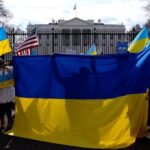
Russia’s violent invasion of Ukraine has upped Western fears of a potential nuclear conflict.
Russian President Vladimir Putin on Sunday ordered his country’s deterrence forces, including nuclear weapons, be put on higher alert, citing so-called threats from the West as Moscow continues to push into Ukraine.
A senior United States defense official said on Sunday of Putin’s order, “It’s clearly, essentially, putting in play forces that, if there’s a miscalculation, could make things much, much more dangerous.”
The official also told reporters the U.S. has “no reason” to doubt Putin’s new order, which they called “unnecessary” and “escalatory.”
Putin flouted Moscow’s nuclear might as he launched an attack on Ukraine Thursday, warning in a speech that countries that interfere with Russian actions will face “consequences you have never seen.”
That threat sparked concerns that an emboldened Russia may be willing to use nuclear weapons should the situation escalate. Such a move could quickly pull the U.S. into the conflict and end up pitting the two largest nuclear-armed states against each other, experts say.
“The Russian government’s decision to send troops into Ukraine threatens to spiral into wider conflict with unpredictable and far-reaching results,” Derek Johnson, a leader of the international nuclear abolition group Global Zero, said in a statement.
“The greatest risk of nuclear use today comes from unplanned or unexpected escalation from a conventional conflict. With NATO and Russian forces operating in close proximity, the threat of one mistake, misinterpretation, or miscalculation during a close encounter or military exercise increases the risk of escalation to direct conflict and potential nuclear use,” Johnson continued.
While the U.S. and Russia are not in direct conflict – President Biden has insisted that no U.S. forces will fight in Ukraine – the administration has ordered more than 14,000 American troops to locations in Europe in the event of a spillover into neighboring alliance counties.
NATO has also, for the first time in history, activated its response force, which is comprised of around 40,000 multinational land, air, maritime and special operations personnel the alliance can deploy on short notice as needed.
NATO Secretary General Jens Stoltenberg on Sunday said that Putin’s order to place Russia’s nuclear arms on high alert is part of a “dangerous rhetoric,” and is exactly why the alliance has moved to bolster its defenses.
“If you combine this rhetoric with what they’re doing on the ground in Ukraine, waging war against an independent sovereign nation, conducting a fully-fledged invasion of Ukraine, this adds to the seriousness of the situation,” Stoltenberg told CNN’s Dana Bash.
But Putin, who views Ukraine as a breakaway state that should fall under Moscow’s control, has made stark warnings to any country that moves to step in and join the conflict.
“Whoever tries to hinder us, and even more so, to create threats to our country, to our people, should know that Russia’s response will be immediate. And it will lead you to such consequences that you have never encountered in your history,” Putin said Thursday.
“Even after the dissolution of the USSR and losing a considerable part of its capabilities, today’s Russia remains one of the most powerful nuclear states. Moreover, it has a certain advantage in several cutting-edge weapons,” Putin continued.
Asked about the status of the U.S. nuclear force following Putin’s latest order, the senior defense official told reporters that the Pentagon does not discuss “specifics of our strategic deterrent posture.”
The official would only say that the U.S. remains “confident in our ability to defend ourselves and our allies and our partners, and that includes in the strategic deterrent realm.”
Russia has an estimated stockpile of about 4,477 warheads meant for long-range launchers and shorter-range tactical nuclear weapons, nearly 1,590 of which are deployed on land-based missiles, submarine launched missiles and bombers, according to the Nuclear Information Project at the Federation of American Scientists.
The stockpile, which is slightly larger than that of the United States, mainly serves as a deterrent against attack, with the understanding that should either side drop the first bomb, it would mean annihilation for everyone.
Russia over the last several years has flouted its nuclear abilities with countless exercises, including simulated nuclear weapon launches, as a wink to NATO of its capabilities. The latest such test took place less than a week before Russia’s invasion into Ukraine.
Although the Pentagon has planned for a scenario in which two major nuclear powers go up against each other, there’s no clear answer as to what the outcome would be.
And though it is unlikely Putin would directly attack NATO troops or territory, there is always the risk of an accident in the fog of war setting off an international conflict.
Nations have come dangerously close to such conflicts in several high-profile skirmishes in the last decade, including when a Russian jet was downed by NATO ally Turkey in 2015 after the warplane crossed into Turkish airspace.
Another potentially explosive standoff ensued when Russian forces in 2014 shot down a commercial airliner, Malaysia Airlines Flight 17, over Ukraine, killing all 283 passengers and 15 crew members on board.
To lower chances of a nuclear tit-for-tat, Washington for years has attempted to draw Moscow into negotiations to limit certain short-range weapons, but the Kremlin has refused.
The two sides do have an agreement in place known as the New START treaty – a deal to limit each country’s number of nuclear launchers – but that will expire in 2026.
The countries also had plans to engage in further talks on the future of arms control, known as the Strategic Stability Dialogue, but those discussions have been thrown into doubt after Russia’s decision to invade Ukraine.
“At this point, we do not have any plans for the next iteration of the Strategic Stability Dialogue,” State Department spokesman Ned Price told reporters Friday.
“The fact that the United States and the Russian Federation have the two largest nuclear arsenals on the planet – it would remain in our national security interest to see to it that nuclear material, nuclear warheads, that nuclear stockpiles remain under control [and] . . . as small as possible,” Price continued.
Still, there’s little expectation that Putin will move to use Russia’s nuclear weapons.
Caitlin Talmadge, an associate professor of security studies at Georgetown University wrote on Twitter that he is likely using the threat as a shield behind which he can “pursue conventional aggression,” knowing that it “may deter outside intervention.”




